Want to learn how to make melt and pour soap? Try this simple melt and pour soap recipe: an exfoliating argan oil soap scented with rosemary and lemongrass essential oils.
This recipe is very complete and will teach you the basics of making melt and pour soap: you can learn not only to work with melt and pour soap bases, but also to use essential oil blends, colorants and exfoliating seeds. It’s the best to start with your soapmaking adventure!
Table of Contents
- How To Make Melt And Pour Soap – A Tutorial
- Tips and Tricks
- Homemade Exfoliating Melt and Pour Soap Recipe
- How To Use This Soap
- Related Posts
- Melt and Pour Soap Making Tutorial Video
- Melt and Pour Soap Making Lessons
How To Make Melt And Pour Soap – A Tutorial
Making melt and pour soap is very easy. As the soap itself is pre-made for you, you don’t need to deal with lye or harsh chemicals, you don’t need to wait weeks to cure the soap, and you can solely focus on design, colors and fragrances. Only the fun part for you!
Here are the generic steps to make melt and pour soap:
- Cut the soap base in cubes (around 1,5 cm)
- Melt the soap base in the microwave, or an eletrical stove.
- Add oils, plant extracts or seeds for additional soap properties (conditioning, exfoliation, anti-inflammatory, anti-microbial, soothness, etc.)
- Add a colorant. If you wish to make layered soap, you will need to divide the soap and add different colorants to each portion.
- Add essential oils or fragrance oils for scent
- Pour in the soap molds
- Let it cool and harden for 1-3 hours
- Once the soap is hard, wrap it in transparent film to prevent the soap from “sweating” (getting small drops of water in its surface)
In this recipe, the exact steps will be:
- Cut the soap base in cubes (around 1,5 cm)
- Melt the soap base in the microwave, or an eletrical stove.
- Still under heat, add the oil and then the yellow colorant (dispersed in a bit of water) and mix well
- Add the chia or poppy seeds and mix
- Pour your soap in individual soap molds (hearts)
- Let the soap harden for 1 to 3 hours
- Wrap the soap in transparent film – it’s ready to use!
It looks – and is! – really simple. Follow the recipe below and feel empowered to make your own soap at home! However, pay attention to the follwoing tips and tricks.

Tips and Tricks
Making make melt and pour soap at home is really easy. But no matter how easy, each craft has its own tips and tricks. Follow these tips and tricks to make melt and pour soap, and you won’t have any issues with your soap:
Melt the base at SLOW HEAT
You can use the microwave, but the best way to do this is by using an electric stove, as you control the temperature much better. Heat it at 50ºC, just be patient and do not feel tempted to rise the heat to accelerate the process. I’ve heard different theories about using bagne-marie, being the issue the water vapor getting in touch with the soap base. While it’s the mildest way to heat any ingredient, if you are going to use it, make sure to close your double boiler with a lid.
Do not let the soap base to boil
Well, you can, but your soap will sweat and might not work generally as good as if you don’t. If the soap base boils be ready for a set of issues with your soap. It also might chemically change the soap base or your addictives and weaken its properties.
Natural or not?
Still about soap bases, bear in mind that many of them are made using surfactants (synthetic ingredients that work as a detergent). Although they are usually milder than commercial soaps, they are no guarantee that you are using natural ingredients, or a truly soap base. Learn how to recognize synthetic and natural ingredients in Commercial Soap Ingredients – What Are They? and make sure you always read the soap base ingredients label.
Be careful with temperature in general
Some plant extracts and essential oils are sensitive to temperature. Make sure you add them when the soap base is cooling. Ideally, at 50ºC (122ºF) or below, it should be safe.
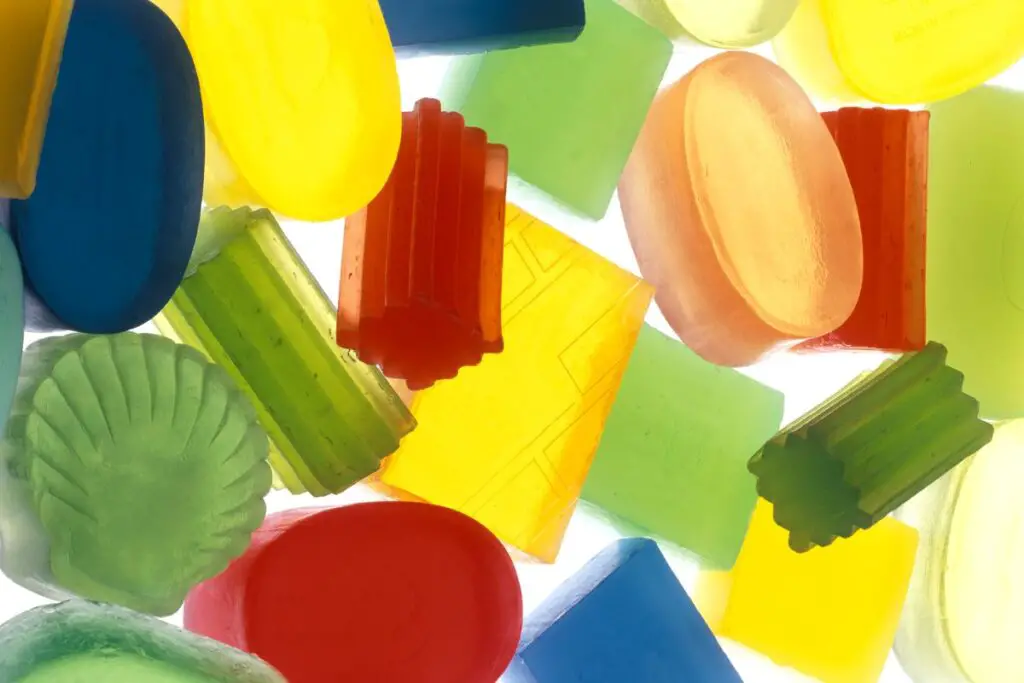
Respect and be strick about supplier’s recommendations regarding colorants and fragrances quantities
Colorants and fragrances very often contain allergens and other chemicals. Do not feel tempted to add “a bit more” after reaching maximum recommended percentages, as you can be risking several issues, like sweaty soap, too-soft soap, or even serious ones like skin irritation and allergies!! You do not want that to your customers and family, or even yourself…. See this post about Best Essential Oils for Soap Making, it uses the EU strick rules for maximum dosages in soap making.
Avoid too much addictives
If you want your soap to be used by people with skin conditions, be modest with the addictives you use. Be aware that colorants and essential/fragrance oils are the most irritating substances for skin. Use natural colorants (like clays), or skip them entirely. Make unscented soaps. Use soothing plant extracts like oatmeal or aloe vera. In this case, simpler is better.
Soap sweating
This is the most common issue with melt and pour soap. The soap develops drops of water around it, and gains a “sweaty” looks. While it’s not an issue for the soap itself, it doesn’t look very good, and it gives a sense of “spoiled” soap (something is wrong with it as it is leaking water). To avoid it, the best way is to wrap the soap in shrink-wrap paper or transparent film as soon as it gets solid; do not overheat the soap base; do not place the soap in the freezer to solidify. See this post english from a famous melt and pour brand – Stephenson – or see this post in portuguese from a handmade soap blog.
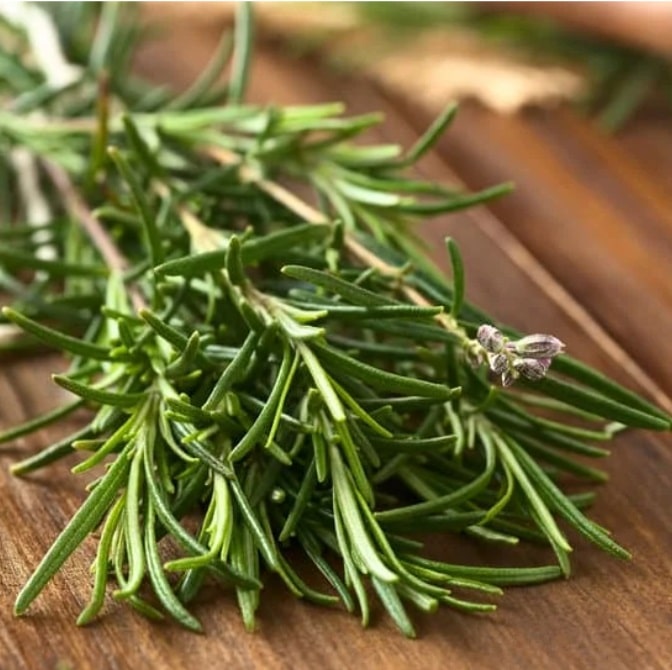
Homemade Exfoliating Melt and Pour Soap Recipe
This recipe uses an argan oil soap base. Why argan oil? It is rich in essential nutrients, antioxidants and anti-inflammatory compounds. It’s popularly used to moisturize skin and hair. I’ve made an argan oil-based conditioner for my hair and I can state that it is truly conditioning.
If you are having trouble finding an argan oil soap base, you can actually use any melt and pour soap base. You can even make your own at home! But to start it’s better to simply purchase one.
The coloring is given by a yellow iron oxide a mineral colorant considered natural. The exfoliation is given by chia or poppy seeds.
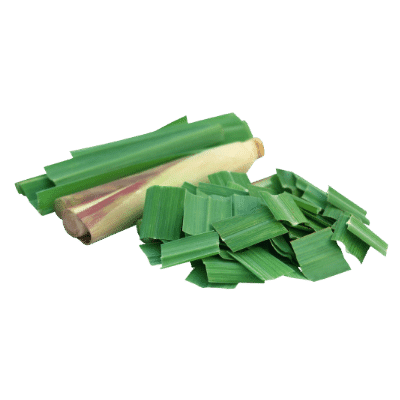
The scent is a mix of rosemary and lemongrass essential oils. I’ve made this with 5 ml of each essential oil for 1 Kg fo soap base and it smelled good! For me, it was enough. But you can go as high as 30 ml (3% of soap base). In the recipe I choose a middle ground: 12 ml.
In any case, try to use a low quantity of fragrance/essential oils. Not only your soap will be more natural (fragrances, essential oils included, have allergens), but you will also spare a lot of money! Essential oils usually double the price of an entire soap batch…
You don’t believe it?
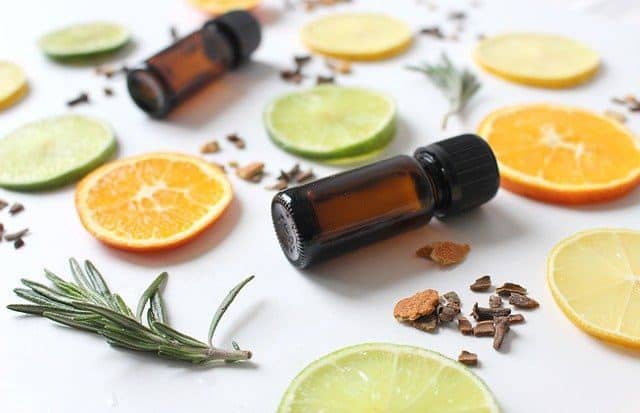
Let’s do some math: the cheaper essential oils are around 4€/10 ml or $6/0,33 fl oz. Assuming that your soap base is 10€/Kg or $16/32 oz, and that you can use a maximum of 3%, you go easily to 30 ml or 1 oz, meaning that your essential oil spending is around 12€ or $18!! More than the entire soap base!
With a lot or a little of essential oils, do have fun with your soap making and your soaps!!
How To Use This Soap
In the shower or bath, wet your hands and rub your soap in them to create a lather. Wash your hands first, then repeat the process and apply soap to your whole body using the soap directly and your hands. You may also wash your face with it. Rinse hands and body abundantly. Also wash your soap from lather before placing it in your soap dish or bag saver.
Washcloths and sponges should be avoided. Avoid washing your intimate zone and your hair, soap pH in not adequate for those parts of your body. Avoid eye contact with soap to prevent stinging. Make a patch test before using your soap. Stop using your soap if you feel any immediate adverse reaction in your skin (red skin, rashes, itching).
To take best advantage of your handmade soap (made by yourself or store-bougth), read How Do You Use Handmade Soap?
Related Posts
Ingredients and Recipes
- Vegetable oils: Oil Properties For Soap Making
- Essential oils: Best Essential Oils for Soap Making
- Colorants: How To Color Your Soap With Kitchen Ingredients
- Beginner Recipes: Soap Recipes for Beginners
- Melt And Pour Soap Base Recipes: Soap Bases Recipes Category
- Melt and Pour Recipes: Recipes Using Melt and Pour Soap Base
Soap Making Techniques and Troubleshooting
- Melt and Pour Soap Tutorial: How To Make Melt and Pour Soap
- Soap Making Methods: How To Make Soap At Home
Melt and Pour Soap Making Tutorial Video
Melt and Pour Soap Making Lessons
The tutorials in this blog are a great – and free! – help to start with melt and pour soap making – even because it’s so easy to do. Practice is the next step to harness the art of making soaps at home. However, I understand if you prefer to have some formal lessons, where you will feel more supported with the steps. Feel free to join these courses at Udemy.
Equipment
Ingredients
- 1 kg melt and pour white soap base
- 3 tsp distilled water
- 8 ml rosehip seed oil
- 8 ml sunflower oil
- 1 tsp yellow iron oxide (CI 77492) yellow mica
- 1 tsp poppy seeds (can be chia as well)
- 7,5 ml essential oils blend
Essential Oil Blend
- 1 tsp essential oil lemongrass
- 1 tsp essential oil sweet orange
- 1 tsp essential oil rosemary
Instructions
- Measure all ingredients first: the oils, the essential oils, the seeds, water and the colorant

- Mix the colorant with the water
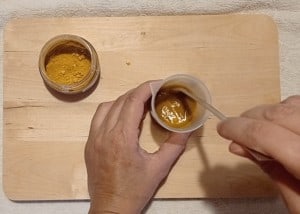
- Cut the melt and pour soap base into small cubes (2 cm x 2 cm x 2 cm) into your bowl or pan, adding a little bit of water (not from the 3 spoons)
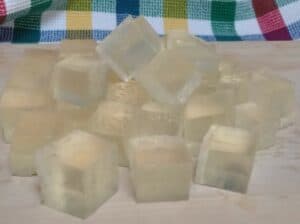
- Take it to an electric stove and set the heat to medium. Let the soap base melt completely. Spray with alcohol if you have a solid layer at the surface.

- Turn off the heat. Add the water with colorant and the oils and mix well.
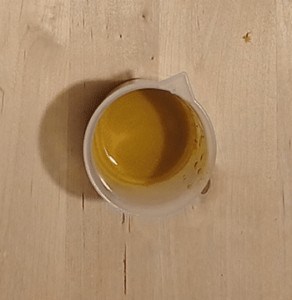
- Add the essential oils and the chia seeds, when the soap is at its lowest temperature, and mix well. If the soap base hardens, heat it a little more.
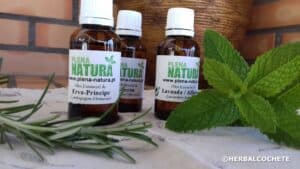
- Pour the soap into the soap molds. Sprinkle the soap surface with alcohol to prevent bubbles and to clear the thin solid layer covering the soap surface

- Let it harden for around 1-3 hours. When fully solid, unmold the soap and cover it in thin plastic film. It's ready to store and sure!!
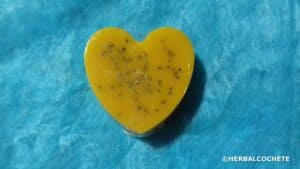
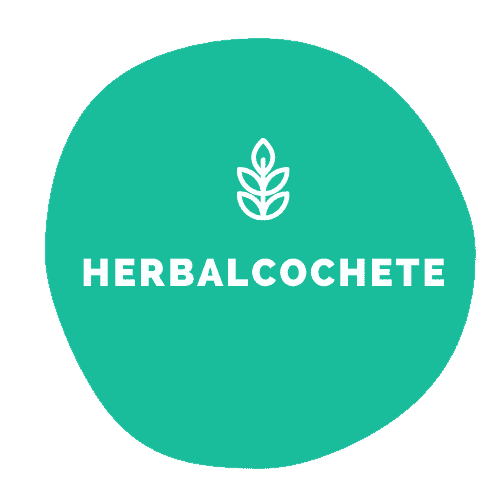
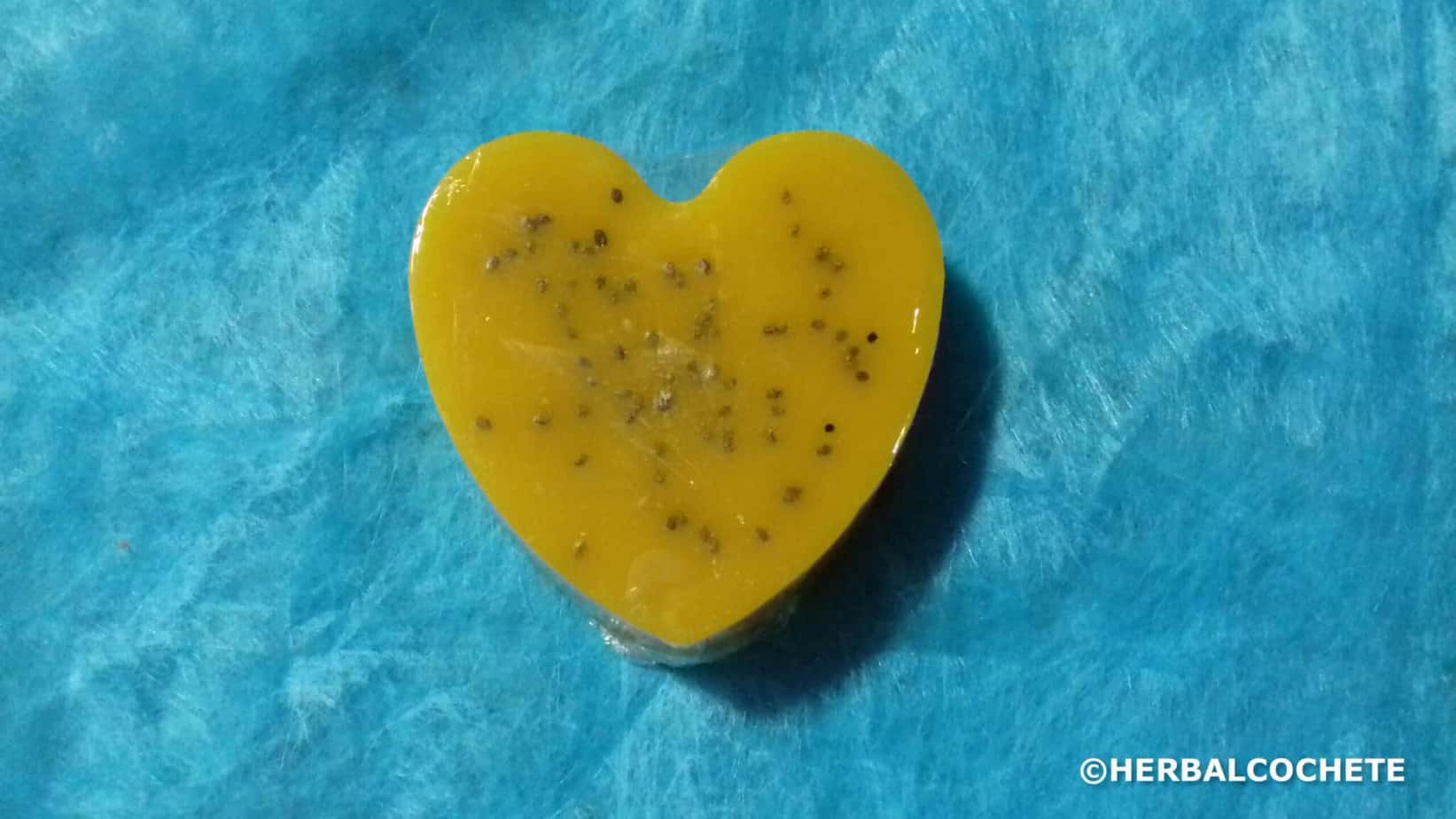



Thanks for the details and recipe for making soaps. I tried this as a hobby last year (covid project!) but was really frustrated with the whole process. I had two main issues – any help would be appreciated.
part 1 –
melted soap started solidifying before it was all poured into the molds – the house was at “room temperature” of approx low 70s F. was the house too cold? is there an ideal temperature to work with?
part 2 –
one batch looked great and included a pale yellow color – but the finished soap stained fabrics with a dark color (not even yellow) when used to spot treat/wash a white garment that got a stain at dinner. what caused that dye in the soap to stain something instead of clean it?
Thank you so much – i’d love to do this again and get it right this time!
Hello Aly, thanks for your comment, and interesting question.
I’m afraid I can’t help you much, as I’ve only used store-bought melt&pour; once – and it went well. But I’ll share you my knowledge about the subject.
First, get a kitchen thermometer and have your melt and pour soap base between 60ºC – 50ºC (140ºF – 122ºF), or use the manufacturer’s recommendations. All until your soap is ready to pour. The soap base usually has a tendency to get a solid layer on top. You can dissolve that by sprinkling alcohol. Maybe these will help you with the soap base getting solid.
As for your staining issue, it seems that either the dye, the fragrance or any substance in the soap base (assuming you didn’t add any more addictives) reacted with your spot, and left a mark. And no, dyes, fragrances or the soap itself shouldn’t do that. But, again, soap bases are usually not really soap, but made with surfactants and some chemical addictives. And who knows what they put in dyes?
Real soap doesn’t stain, unless you are using a staining dye (indigo, for example). My experience with cold process or liquid soap done from scratch is that it removes quite well difficult stains, and I’ve never experienced it staining anything.
Cheers,
Sofia